In this post, I will take you through the special stitches and techniques that you will be using during the Scheepjes Ubuntu CAL 2018. The photo tutorials below will help familiarise you with the skills needed to complete the crochet-along.
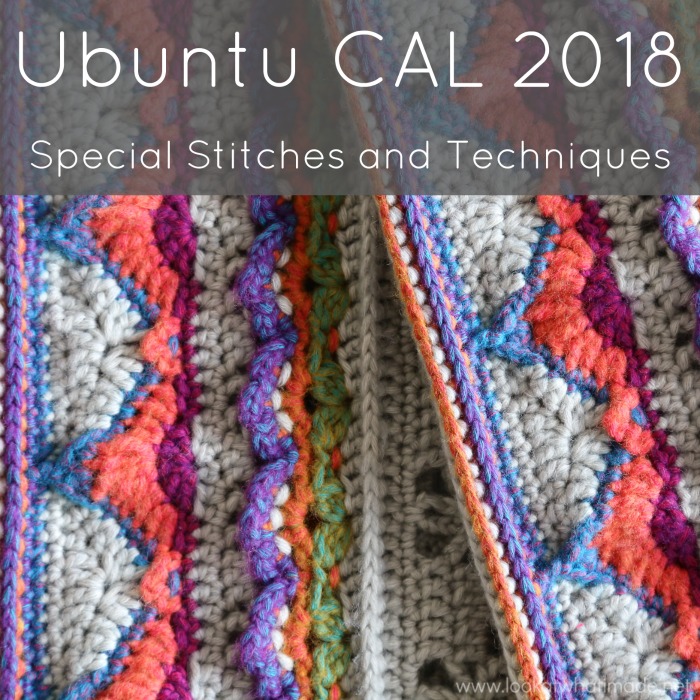
Please note that it is not essential for you to read through the photo tutorials below. All the information can be found in the written-only ‘Tips and Tricks’ PDF, which you can find HERE (scroll to bottom after clicking the link).
Every step of the pattern will also be explained thoroughly as Esther from It’s All in a Nutshell takes you through the weekly video tutorials. [I will add a link to those as soon as the CAL starts on the 12th of September].
Resources
Index
- Abbreviations
- Punctuation
- Special Stitches
- Techniques
Abbreviations
US Terminology
The Ubuntu CAL pattern is available in US and UK terminology. Please note: Although the videos are in UK terminology, my photo tutorials below are in US terminology.
- Beg – Beginning
- BP – Back post
- CC – Contrasting colour
- Ch – Chain
- Dc – Double crochet
- Dtr – Double treble crochet
- FP – Front post
- Hdc – Half-double crochet
- MC – Main colour
- Rem – Remaining
- RS – Right side
- Sl st – Slip stitch
- SM – Stitch marker
- Sp/sps – Space/spaces
- St/sts – Stitch/stitches
- Tr – Treble crochet
- WS – Wrong side
Punctuation
* An asterisk indicates pattern repeats. You will need to repeat all the instructions between asterisks the number of times specified. This is a hard-core repeat and will consist of multiple instructions. Due to the complex nature of the instructions for the Diamonds, these instructions will be highlighted in grey in the first 3 parts of the pattern.
Parentheses () indicate repeats. You will need to repeat the instructions between parentheses the number of times specified. This is a lower level repeat. Parentheses are also used to indicate a group of sts to be worked into the same st/sp.
Square Brackets [] are used to indicate a group of sts to be worked in the same st/sp when using parentheses would be too confusing.
Curly Brackets {} are used to indicate additional information and photo references.
Special Stitches
2-dc Bobble
- Yarn over and insert your hook into the indicated st/sp. Yarn over and draw up a loop {3 loops on hook}. Yarn over and pull through 2 loops {2 loops on hook}.
- Yarn over and insert your hook into the same st/sp. Yarn over and draw up a loop {4 loops on hook}. Yarn over and pull through 2 loops {3 loops on hook}.
- Yarn over and pull through all 3 loops on your hook.

3-dc Bobble
- Yarn over and insert your hook into the indicated st/sp. Yarn over and pull up a loop. Yarn over and pull through 2 loops {2 loops on hook}.
- Yarn over and insert your hook into the same st/sp. Yarn over and pull up a loop {4 loops on hook}. Yarn over and pull through 2 loops {3 loops on hook}.
- Yarn over and insert your hook into the same st/sp. Yarn over and pull up a loop {5 loops on hook}. Yarn over and pull through 2 loops {4 loops on hook}.
- Yarn over and pull through all 4 loops on your hook.

Cluster Stitch
This stitch is also known as a dc3tog (double crochet 3 together).
- Yarn over and insert your hook into the indicated st. Yarn over and draw up a loop {3 loops on hook}. Yarn over and pull through 2 loops {2 loops on hook}.
- Yarn over and insert your hook into the next st. Yarn over and draw up a loop {4 loops on hook}. Yarn over and pull through 2 loops {3 loops on hook}.
- Yarn over and insert your hook into the next st. Yarn over and draw up a loop {5 loops on hook}. Yarn over and pull through 2 loops {4 loops on hook}.
- Yarn over and pull through all 4 loops on your hook.

Dc2tog
- Yarn over and insert your hook into the indicated st/sp. Yarn over and draw up a loop {3 loops on hook}. Yarn over and pull through 2 loops {2 loops on hook}.
- Yarn over and insert your hook into the next st/sp. Yarn over and draw up a loop {4 loops on hook}. Yarn over and pull through 2 loops {3 loops on hook}.
- Yarn over and pull through all 3 loops on your hook.

Dtr Bobble
- Yarn over three times and insert your hook into the indicated st/sp. Yarn over and pull up a loop. (Yarn over and pull through 2 loops) three times {2 loops on hook}.
- Yarn over three times and insert your hook into the same st/sp. Yarn over and pull up a loop {6 loops on hook}. (Yarn over and pull through 2 loops) three times {3 loops on hook}.
- Yarn over three times and insert your hook into the same st/sp. Yarn over and pull up a loop {7 loops on hook}. (Yarn over and pull through 2 loops) three times {4 loops on hook}.
- Yarn over and pull through all 4 loops.
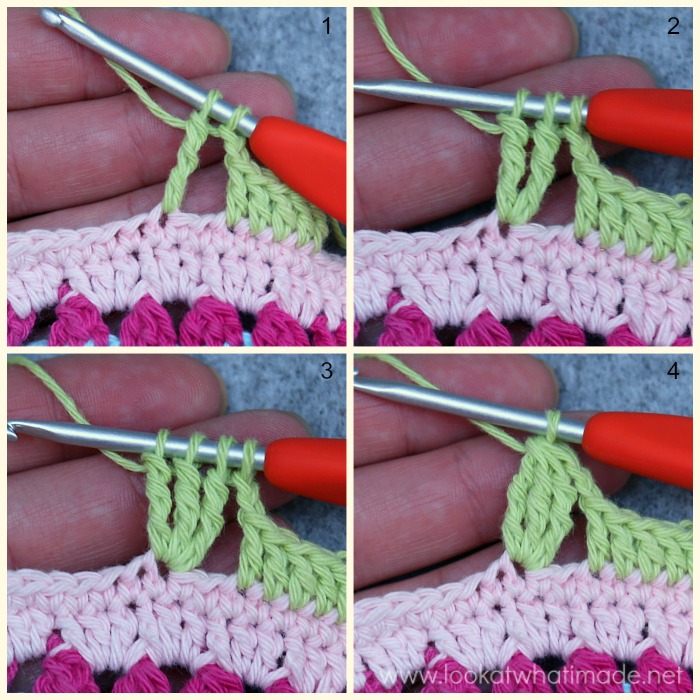
Popcorn Stitch
- Make 5 dc in the indicated st/sp.
- Remove your hook from the last dc and insert it into the first dc of the 5-dc group. Grab the last st with your hook.
- Pull the last st through the first st to complete the Popcorn.

When working into the Popcorn in subsequent rounds, it is important to note that the top of the Popcorn will be the first dc of the 5-dc group that forms the Popcorn.
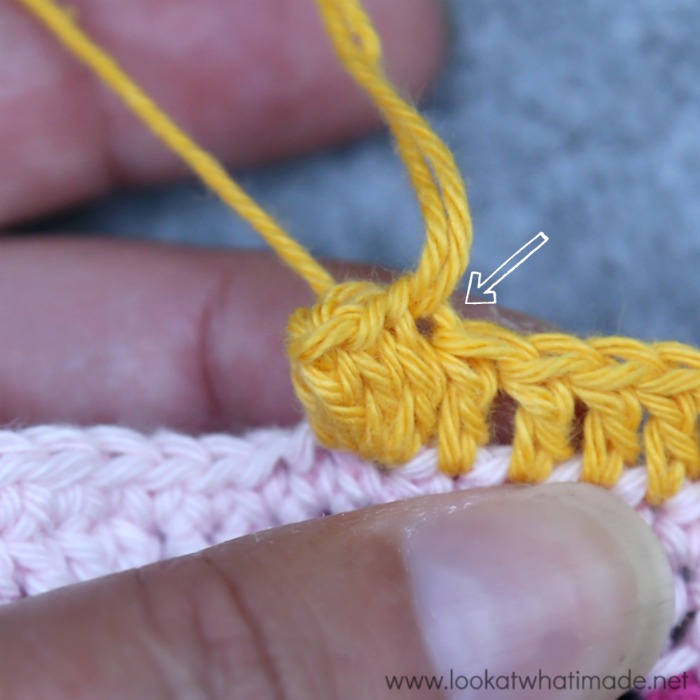
Tr Bobble
- Yarn over twice and insert your hook into the indicated st/sp.
- Yarn over and pull up a loop. (Yarn over and pull through 2 loops) twice {2 loops on hook}.
- Yarn over twice and insert your hook into the same st/sp. Yarn over and pull up a loop {5 loops on hook}. (Yarn over and pull through 2 loops) twice {3 loops on hook}.
- Yarn over twice and insert your hook into the same st/sp. Yarn over and pull up a loop {6 loops on hook}. (Yarn over and pull through 2 loops) twice {4 loops on hook}.
- Yarn over and pull through all 4 loops on your hook.

V-stitch
(Dc, ch 1, dc) in the indicated st/sp.
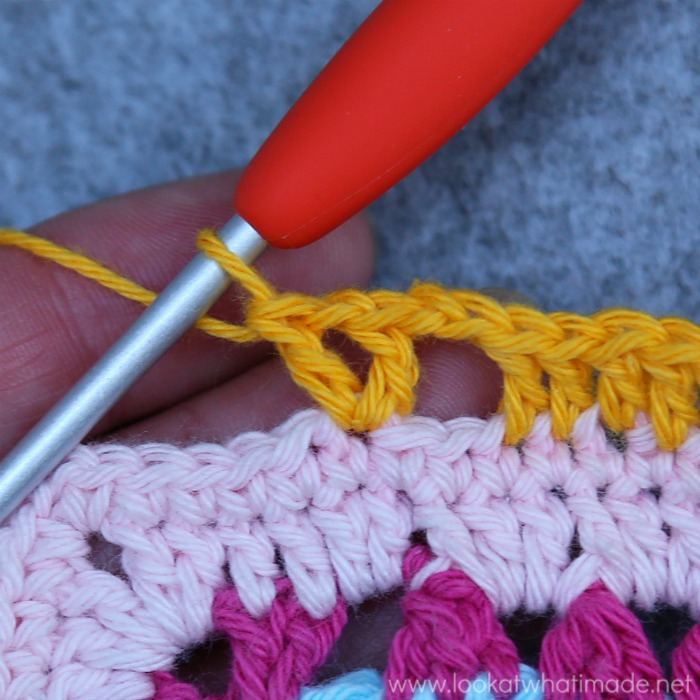
Techniques
Gauge
Gauge is incredibly important when you are making an item ‘to size’. Usually, matching gauge in a blanket isn’t essential if you don’t mind how big (or small) it will turn out or how much yarn you will use. When you are using yarn supplied as part of a kit, though, it becomes VERY important as the yardages for the kits have been calculated with a specific gauge in mind. A small increase in gauge size can cause an exponential increase in yarn needed.
Due to the diamond shape of Part 1, you might find it difficult to measure your piece accurately when instructed to check gauge. To avoid a lot of head-scratching and worry, I have two suggestions which will, hopefully, ensure that we start our journey on a joyous note.
The first suggestion is that you make a gauge square while you wait for Part 1 of the CAL (I will tell you about that in a minute). The second is that you weigh your diamond/diamonds at the end of each of the first 3 parts to check how your yardage compares to mine. This will be the most accurate indicator of yarn usage. It is also a good idea to familiarise yourself with the Golden Loop Method (also known as ‘Yankers, Lifters, and Riders’). I am a rider, just in case you wanted to know :)
Making a Gauge Square
Please follow Rounds 1 – 7 (NOT 8) of my free Emma Square Pattern, using the hook, colour, size, and weight below as a guideline.
Small Gauge Square
Using a 3mm hook and CC2 (pink) of the Small Kit, your square should measure 9cm/3.5″ and weigh 4g. If your square is slightly smaller, you’ll be fine. If your square is larger, drop down to a 2.75mm hook and try again.

Medium Gauge Square
Using a 3.5mm hook and MC (Moonstone) of the Medium Kit, your square should measure 10.5cm/4.1″ and weigh 7g. If your square is slightly smaller, you’ll be fine. If your square is larger, drop down to a 3.25mm hook and try again.
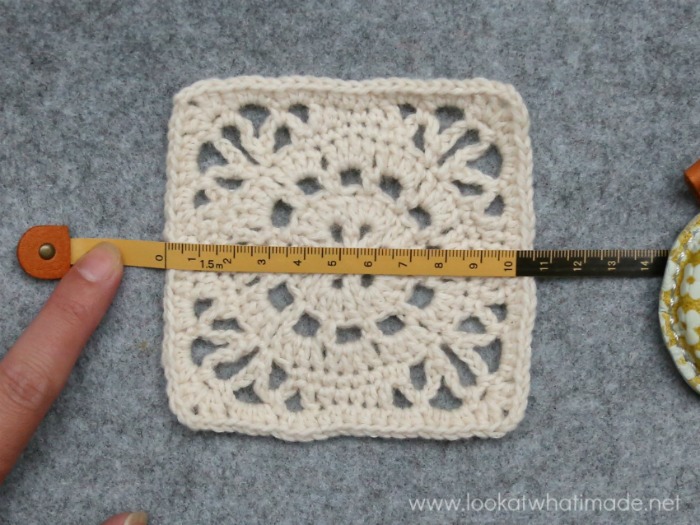
Large Gauge Square
Using a 5mm hook and MC (Crystal Quartz) of the Large Kit, your square should measure 14cm/5.5″ and weigh 16g. If your square is slightly smaller, you’ll be fine. If your square is larger, drop down to a 4.5mm hook and try again.
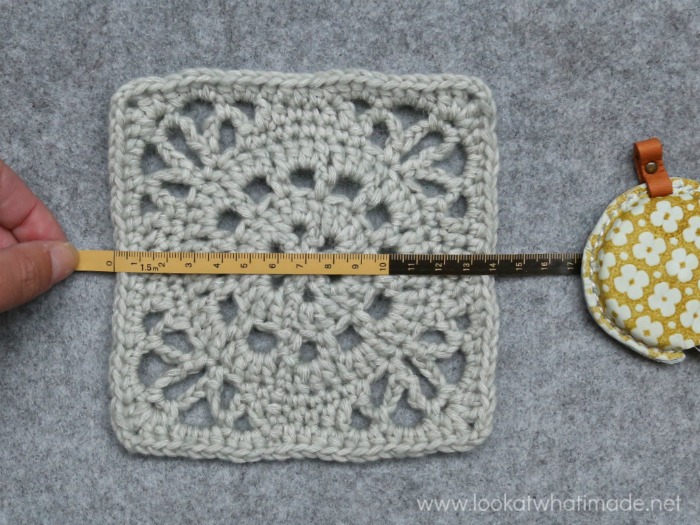
Once you have identified which hook to use to match my gauge, you will know that THAT is the hook you should use when you start the CAL. Remember to still check size and weight as you go, though!
Magic Ring
Magic rings are great because they do not leave a hole in the middle of your project. When using this method it is extremely important that you work your initial yarn end away very well. If it comes undone your whole project might unravel (see Working Away Yarn Ends below).
- Place the end of the yarn in your left palm (right if you are left-handed) and hold it in place with your pinkie and ring finger. Wrap the yarn clockwise around your forefinger so that the working yarn crosses over the yarn end and forms a loop.
- Remove the loop from your finger and hold it by pinching the point where the two strands of yarn overlap.
- Insert your hook into the loop, catch the working yarn end with your hook, and pull it through the loop.
- Yarn over and make a chain stitch. This chain secures your working yarn.
- Following the pattern, work the remainder of the round into the magic ring, remembering to work over the initial yarn end as well.
- When the round is complete, close the hole by pulling on the initial yarn end. Remember to work your yarn end away very well!

Stitch Anatomy
Stitches consist of posts (the bits that go into the stitches of the previous round) and loops (the horizontal ‘V’s formed by the tops of the stitches). Before you start with this pattern, it is vitally important that you know which ‘loops’ belong to which stitch or ‘post’, and vice versa.
When working with the right side (RS) of the last round facing you, the loops for each stitch can be found to the right of the post for that stitch (left if you are left-handed).
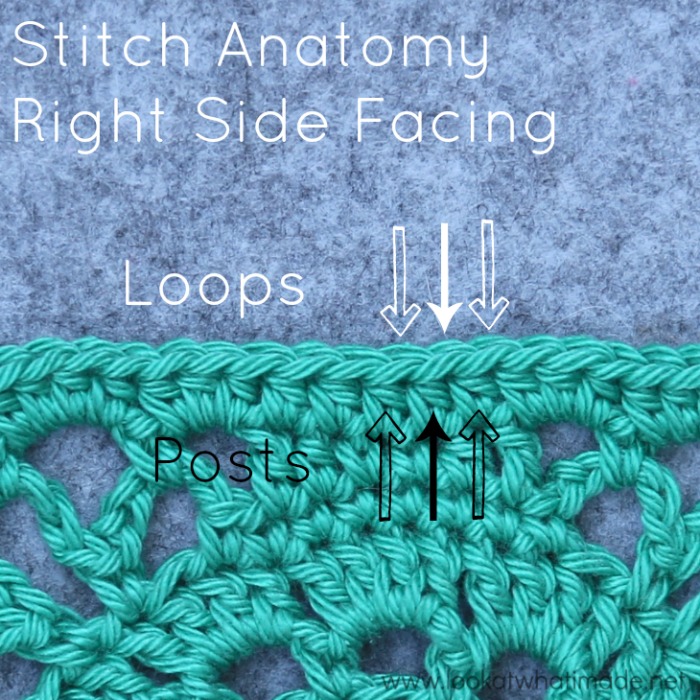
When working with the wrong side (WS) of the last round facing you, the loops for each stitch can be found to the left of the post for that stitch (right if you are left-handed).
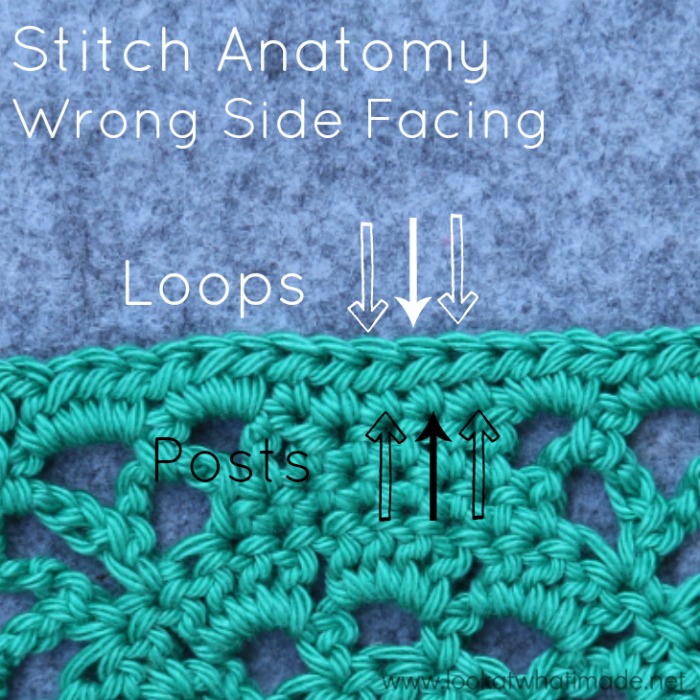
Stitch Count For the First Six Motifs
The first six motifs are made with the RS always facing you. To prevent ‘twisting’ of the motifs, some of the later rounds will have asymmetrical stitch counts for the side after a pointy corner (Side A) and the side before a pointy corner (Side B). In those instances, stitch counts have been provided per Side A and B.
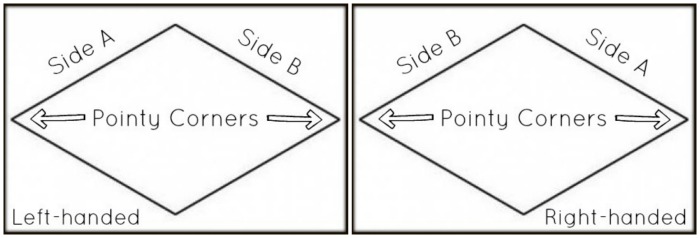
Corners and the Elusive Hidden Stitch
When working in the round, your corners will be formed by working a number of stitches into the corner stitch/space of the previous round. When you’ve made more than one stitch into that corner space (or any other chain space), the loops for the first stitch after the corner (or chain space) can sometimes be hidden.
If you miss this first stitch, your stitch count will be out every single time, no matter how many times you frog and re-do. Sometimes the first stitch after a chain space is NOT hidden, but clearly visible. Even so, I will refer to it as a ‘hidden stitch’, just to remind you to pause and check that you are not accidentally skipping it.
Sometimes you will need to push the stitches out of the way to get into that first stitch. It is worth noting that an hdc directly after any chain space is the most tricky stitch to get into. It is ALSO worth noting that the hidden stitch won’t be nearly as hidden if the WS is facing you.
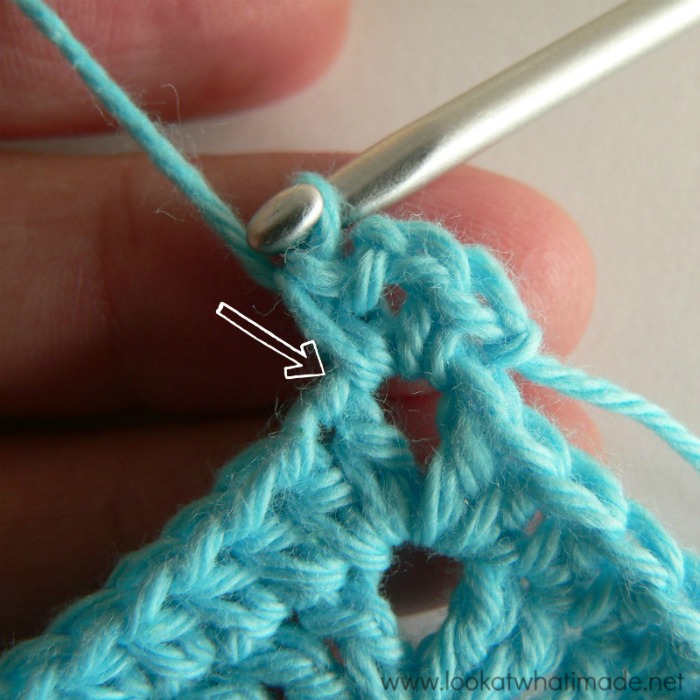
Using Stitch Markers
Occasionally, I will tell you to mark specific stitches with a SM. This will either be to help you count (in which case you can remove the marker after you have counted your stitches), or to help you identify a stitch in later rounds (in which case you should leave the SM until it has served its purpose). To mark a stitch, insert your SM through both loops of the indicated stitch (or into the indicated space). If you need help identifying which loops belong to which stitch, see Stitch Anatomy above.
If you do not have stitch markers (or you don’t have enough), you can use a piece of scrap yarn to mark your work. I often do!
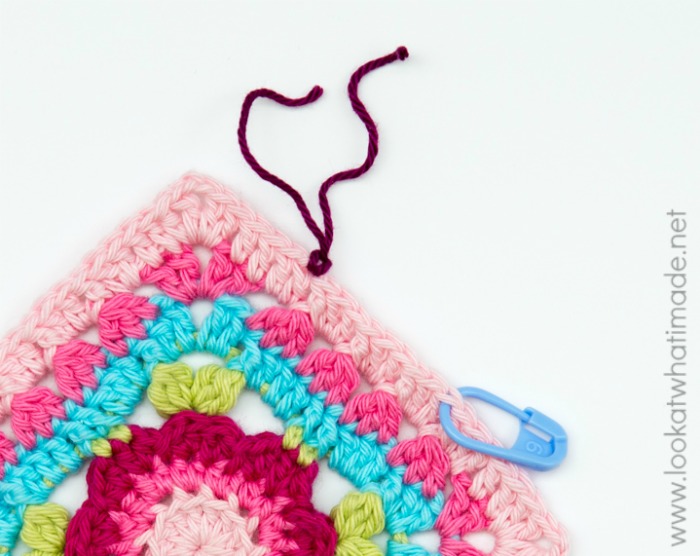
I strongly recommend marking your ch-1 corner spaces with a SM as you go (especially the non-pointy ones) because that is where you will run into the most trouble… at least, that is where I run into the most trouble :)

Standing Stitches
Standing stitches are used to start the round when using a new colour (or starting in a different place from where you finished the previous round). They are exactly the same as regular stitches, except that they are made ‘in air’, without being attached to a previous stitch. With a sl knot already on your hook, and holding the knot in place with your index finger, make your stitch as normal.
As an example, I will show you how to do a standing double crochet.
- With a sl knot already on your hook, yarn over.
- Insert your hook into the indicated st/sp. Press the slip knot against your hook with your right index finger (left, if you are left-handed) to prevent it from spinning around your hook when you yarn over. Yarn over again and pull up a loop {3 loops on hook}.
- Yarn over and pull through 2 loops {2 loops on hook}.
- Yarn over and pull through both remaining loops.

Post Stitches
Front Post Stitches
- Identify the post of the stitch you want to work around. Insert your hook from the front to the back and then from the back to the front around the post of the stitch so that the post lies on top of your hook.
- Complete your stitch as normal.
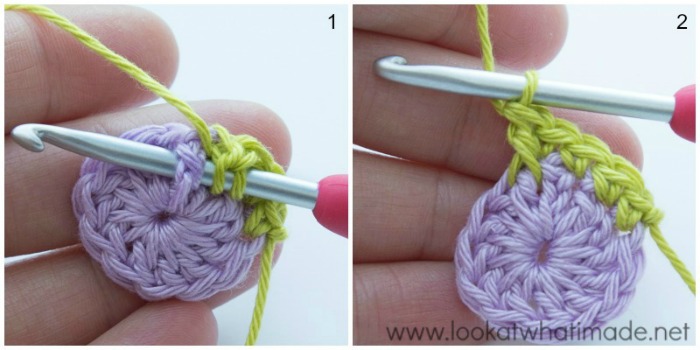
Back Post Stitches
Back post stitches are a bit trickier than front post stitches, but once you get the hang of them you will love them!
- Identify the post of the stitch you want to work around. Insert your hook from the back to the front and then from the front to the back around the post of the stitch so that the post lies behind your hook.
- Complete your stitch as normal.
You might find it easier to twist your work forward so that you can see what you are doing.
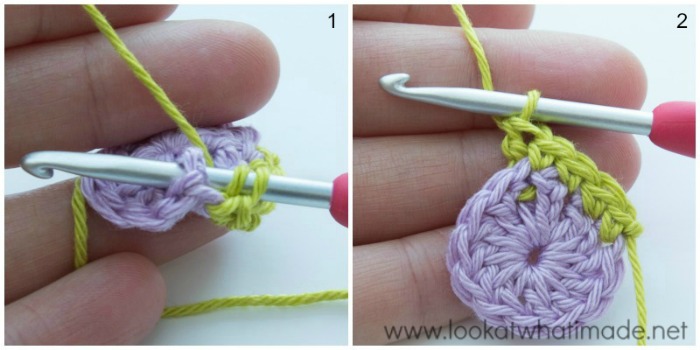
Omitting
At the end of some rounds, you will see an instruction telling you to omit the last corner/stitch(es) of the last repeat. This means that your last repeat should stop before the indicated corner/stitch(es) because you will already have made that corner/stitch(es) before the repeat started.
Changing Colours
You can use this method to join a new colour (or a new ball of yarn) in the middle of a round. If you want to make certain elements of the pattern in a different colour, for example, this is how you would switch between colours in a round.
- You will need to change your colour on the last yarn-over of the last stitch before the colour change. In other words, stop when you have 2 loops left on your hook.
- Let go of the old colour/yarn and pick up the new colour/yarn. Draw the new colour/yarn through both loops to complete the stitch.
- Continue as normal.
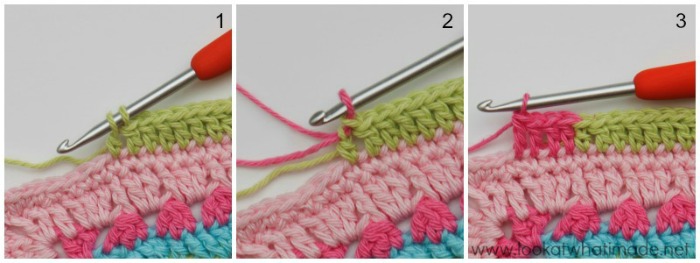
Joining at the End of a Round/Row
- To join your round with a sl st, identify the st you need to join to.
- Insert your hook into the indicated st/sp…
- …and make a sl st. If you are instructed to join to the top of the beg chain, make sure that you don’t accidentally insert your hook into the top of the first st after the beg chain.
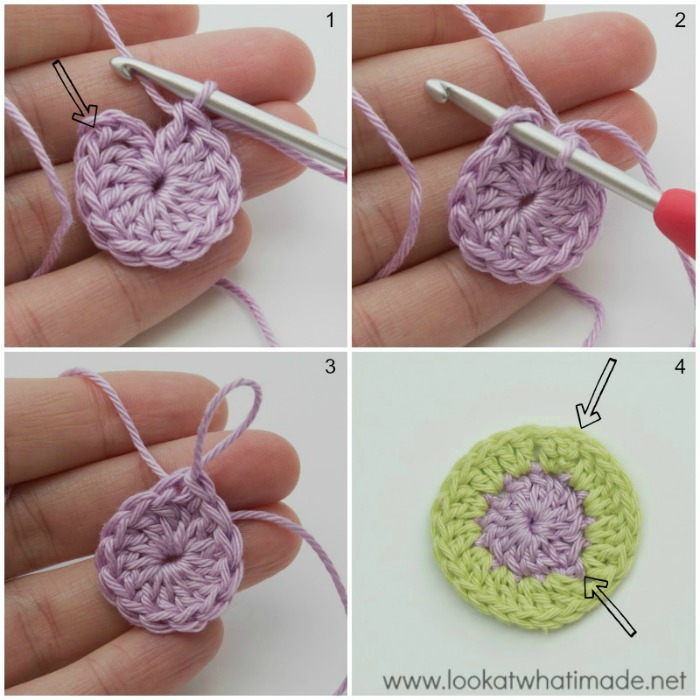
Fastening Off
If you are using a sl st join, cut your yarn about 10cm/4” away from your work (after completing the sl st) and pull the yarn all the way through the st. Work away your yarn ends (see Working Away Yarn Ends below).
Working Away Yarn Ends
Unfortunately, your project is never complete until you have gotten rid of all the “loose ends”. A pattern will usually tell you to work away your yarn ends when you are done, but I suggest working your ends away as you go. To do that you will need a blunt tapestry needle and a pair of scissors.
Thread the tapestry needle with the yarn end. Working on the wrong side of the fabric, thread your needle through at least 2.5cm/1” of stitches. Please note that the wrong side of your project is not necessarily the wrong side of the last row/round made! If you are working away your initial yarn end, thread it through at least half of the stitches made into the magic ring {Photo 1}.
Pull the yarn through all the way. Working in the opposite direction and skipping the first stitch, insert your needle back into the same stitches again. Skipping the first stitch is essential because it gives the yarn something to grip on to {Photo 2}. Pull the yarn through again. You can repeat this one more time if you want to make absolutely sure that your yarn ends won’t work themselves loose {Photo 3}.
Cut the yarn close to your work, being careful not to accidentally cut one of your stitches. If you have done this neatly, your tails won’t be visible on the front of your work.
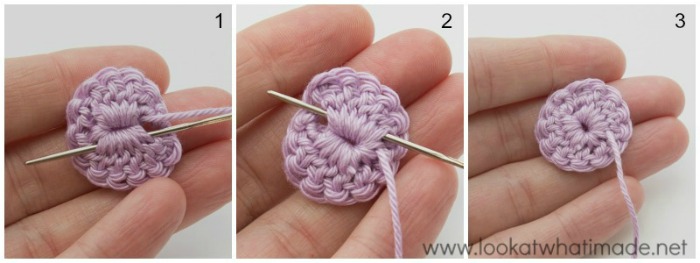
Blocking
You don’t HAVE to block your motifs and/or blanket if you don’t want to, but I always find that a good blocking makes for a great presentation. I prefer to block my motifs before joining so that I can gauge whether or not my join is too tight. This pattern allows for that by suggesting that you use a larger hook for your joining, so if you don’t want to block, don’t block.
If you ARE going to block, immerse your motifs/blanket in water for a couple of minutes. Gently wring out most of the excess water. Place your work between two large towels and roll up like a big cigar so that the towels absorb more of the water.
Unroll again and place your work on your blocking surface. Applying gentle pressure, stretch your work out and use pins to pin it to your blocking surface. Try to avoid creating ‘pointy bits’ when you pin it down. I use a pin every inch or so.
When everything is completely dry, unpin, and marvel at your wonderful work!
Annie’s has some good advice for Blocking Afghans and Other Large Pieces. If you are going to use foam squares to block on, consider buying these Interlocking Foam Exercise Mats. They are similar to these Knitter’s Pride Lace Blocking Mats but cheaper. You will also need some of these Clover Fork Blocking Pins
or regular rust-proof sewing pins.
I hope that this post has answered some of the questions you might have and that you will thoroughly enjoy joining us on this journey.

This blog post contains affiliate links. I only link to products I personally use or would use. All opinions are my own.



spoodle says
hi there :) picked up the kit this week and am excited to get started!
It’s recommended to weigh the diamonds after completion, but nowhere i can find says >how much< they should weigh. Can you possibly point me at a number? I'm using the small kit for reference
Dedri Uys says
Hi :) That information is at the end of Part 3 on my website. Small one should weigh 41 – 44g :)
Debby Lane says
Thank you for the stitch anatomy. That was something I never knew, so I always was doing it wrong. I think patterns may be easier to follow now!
Dedri Uys says
Hi Debby,
I am so pleased for you! It does make patterns much easier when you can identify which bits of a stitch belong to which stitch ;) Enjoy!
Beverly says
Love your tutorial, very well done.
Ma. Carmela ClaroAzurin says
Will a book like Sophie’s Universe come out for the Ubuntu CAL, please?
Dedri Uys says
Not that I am aware of.
Margaret Ann says
Not long found your delicious site – beautiful patterns and your instructions and videos are a pleasure to follow. Will thoroughly enjoy following your equisite work and hopefully joining in.
Jenny says
We hope you get the urge to join in too, Margaret!
Jenny :)
Kate says
I got gauge! I think. Width is 9cm but weight is 5g (with the square still attached to the yarn ball). Apologies for the possibly-foolish question, but was the colour chosen because the amount for the square could be spared? I’m considering undoing it all and reusing it for the CAL proper, but if the gauge square is intended to be measured purely on its own as your photos imply then so be it.
This is my first CAL – really looking forward to it! :)
Dedri Uys says
Hi Kate. That will be fine :) The colour was indeed chosen because the yarn could be spared, but feel free to frog your square and use that yarn too. Tomorrow!!! Exciting :)
Christine Donaldson says
I needed this as I can’t wait. Now I can my square to check size. Thank you.
Jo Hunt says
I am beyond excitement!
Dedri Uys says
So am I!
Suzanne says
Looking forward to start the Ubunto Cal
Eileen Kumar says
Really like your patterns